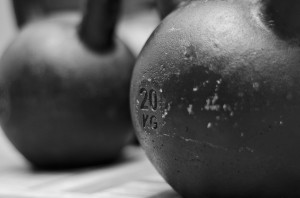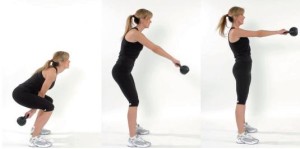The Kettlebell Workout

Kettlebells may seem like a pretty scary piece of fitness equipment. Hold on, there’s no reason to worry – because as intimidating as it may seem, kettlebells are an extraordinary addition to your fitness regimen, given the amount of power and strength the work out leaves you with. Deceptively small in appearance, but packing a massive punch in the actual implementation, kettlebells are a easy to store and add a lot of value in a great strength training workout.

Here are a few things you should know about kettlebells before integrating them into your workout!
– A kettlebell is made out of castiron, and is typically a weight that resembles a cannon ball, with a handle on top.
– Kettlebells are used to do ballistic exercises. They mix a blend of cardiovascular, strength and flexibility training.
– Kettlebells generally come in sizes that range from four pounds (1.8 kg) to 175 pounds (79 kg).
– Kettlebells come in the shape and size that they do, in order to make them very versatile elements in an exercise regimen. They are small, but heavy and dense, and add a lot of value to almost any natural movement – twisting your body, raising your hands above your head, swinging your arms.
– Kettlebells can enhance a very functionality driven workout and turn it into a serious exercise with the addition of a kettlebell.
Here are some of the more common exercises that are done using kettlebells. It is important to have a correct form while doing them in order to avoid injuries:
– The Kettlebell Swing: This is a basic move that is performed with one or both hands. The swing uses your shoulders, core, and thighs. Squat low, and let the kettlebell rest between your legs. Grab the kettlebell and like a deadlift, rise up and push your hips out. Drive the kettlebell up with the force of your lower body and core.
– Kettlebell Clean and Press – Start in the swing position, and while pushing with your hips and legs, swing the bell up while keeping your elbow in – when the bell reaches your shoulder, dip your knees and get your elbow underneath the kettlebell. Hold it at your shoulder. From the clean, you can move into the press state, where you push the kettlebell up over your head with your shoulder and slowly lower it. Return to the squat/swing position and repeat.
– Turkish Sit Ups – Use the kettlebell by holding it straight up in the air with one hand, and lie on your back. Keep your elbow locked. The kettlebell should be resting against your forearm. Prop yourself up on your other hand and bring your left foot toward your buttocks. Put your right knee and left foot on the ground, so that you’re in a half-kneel. Maintain the straight arm and stand up.
References:
http://www.indiatimes.com/health/tips-tricks/exercise-equipment-benefits-of-kettlebell-workouts-243150.html
http://www.indiatimes.com/health/tips-tricks/kettlebell-training-fitness-at-your-fingertips-242196.html
http://indiatoday.intoday.in/story/fitness-exercise-bowka-kettle-bells-hot-yoga-personal-training/1/360366.html
http://timesofindia.indiatimes.com/life-style/health-fitness/fitness/Workout-routines-Kettlebell-workouts/articleshow/17979121.cms


